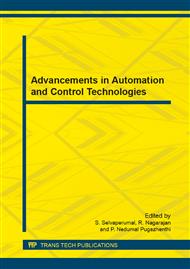[1]
Li Tang, Meindert Niemeijer, Joseph M. Reinhardt, Mona K. Garvin, and Michael D. Abràmoff, Splat Feature Classification with Application to Retinal Hemorrhage Detection in Fundus Images, Medical Imaging, IEEE Transactions Vol. 32, No. 2, pp.364-375, Feb. (2013).
DOI: 10.1109/tmi.2012.2227119
Google Scholar
[2]
Istvan Lazar and Andras Hajdu, Retinal Microaneurysm Detection Through Local Rotating Cross-Section Profile Analysis, IEEE Trans. On Medical Imaging, Vol. 32, No. 2, Feb. (2013).
DOI: 10.1109/tmi.2012.2228665
Google Scholar
[3]
Akara Sopharak, Bunyarit Uyyanonvara, Sarah Barman, Automatic Exudate Detection from Non-dilated Diabetic Retinopathyretinal images using Fuzzy C-Means Clustering, Journal of Sensors, Vol. 9, No. 3, pp.2148-2161, March (2009).
DOI: 10.3390/s90302148
Google Scholar
[4]
Akara Sopharak, Mathew N. Dailey, Bunyarit Uyyanonvara, Sarah Barman, Tom Williamson, Yin Aye Moe, Machine Learning approach to automatic Exudates detection in retinal images from diabetic patients, Journal of Modern optics, Vol. 57, No. 2, pp.124-135, Nov (2011).
DOI: 10.1080/09500340903118517
Google Scholar
[5]
Sai Deepak. K, Sivaswamy. J, Automatic Assessment of Macular Edema from Colour Retinal Images, Medical Imaging, IEEE Transactions, Vol. 31, No. 3, pp.766-776, March (2012).
DOI: 10.1109/tmi.2011.2178856
Google Scholar
[6]
Giancardo. L, Meriaudeau. F, T. Karnowski, K. Tobin, E. Grisan, P. Favaro, A. Ruggeri, and E. Chaum, Textureless macula swelling detection with multiple retinal fundusimages, IEEE Trans. Biomed. Eng., Vol. 58, No. 3, p.795–799, Mar. (2011).
DOI: 10.1109/tbme.2010.2095852
Google Scholar
[7]
Phillips, R.P.; Forrester, J.; Sharp, P. 1993 Automated detection and quantification of retinal exudates. Graefe Arch Clin. Exp. Ophthalmol. 231, 90-94.
DOI: 10.1007/bf00920219
Google Scholar
[8]
Giancardo. L, Meriaudeau. F, Karnowski.T. P, Li. Y, Tobin.K. W, Jr., and Chaum. E, Automatic retina exudates segmentation without a manually labelled training set, in Proc. 2011 IEEE Int. Symp. Biomed. Image: From Nano to Macro, Mar. 2011, p.1396.
DOI: 10.1109/isbi.2011.5872661
Google Scholar
[9]
Giancardo. L, Meriaudeau. F, Karnowski. T, Tobin. K, Grisan. E, Favaro. P, Ruggeri. A, and Chaum. E, Textureless macula swelling detection with multiple retinal fundus images, IEEE Trans. Biomed. Eng., vol. 58, no. 3, p.795–799, Mar. (2011).
DOI: 10.1109/tbme.2010.2095852
Google Scholar
[10]
Alireza Osare et al., A Computational – Intelligence-Based Approach for Detection of Exudates in Diabetic Retinopathy Images, IEEE Transactions on Information Technology in Biomedicine, Vol. 13, No. 4, pp.535-545, July (2009).
DOI: 10.1109/titb.2008.2007493
Google Scholar
[11]
David. J Rekha Krishnan, Sukesh Kumar. A, Neural Network based Retinal image analysis, " IEEE Conference on 'Image and Signal Processing, 49-53, DOI 10. 1109/CISP. 2008. 666, Sep (2008).
DOI: 10.1109/cisp.2008.666
Google Scholar


